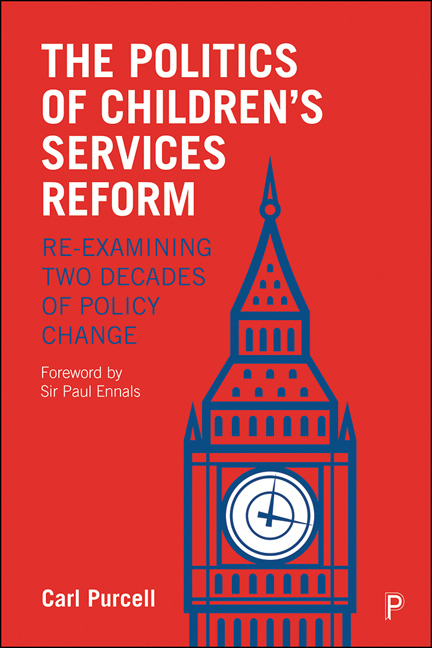Book contents
- Frontmatter
- Dedication
- Contents
- List of Abbreviations
- Acknowledgements
- Foreword
- Introduction
- 1 What Drives Children’s Services Reform?
- Part I Children’s Services Reform Under the Labour Government (1997– 2010)
- Part II Children’s Services Reform Under the Coalition and Conservative Governments (2010– 19)
- Conclusion: the Politics of Children’s Services Reform
- Appendix: Chronology of key Reports
- References
- Index
6 - The Children’s Plan, ‘Broken Britain’ and Baby P
Published online by Cambridge University Press: 03 March 2021
- Frontmatter
- Dedication
- Contents
- List of Abbreviations
- Acknowledgements
- Foreword
- Introduction
- 1 What Drives Children’s Services Reform?
- Part I Children’s Services Reform Under the Labour Government (1997– 2010)
- Part II Children’s Services Reform Under the Coalition and Conservative Governments (2010– 19)
- Conclusion: the Politics of Children’s Services Reform
- Appendix: Chronology of key Reports
- References
- Index
Summary
Introduction
With schools, children's services, the voluntary sector and government all playing their part, we can ensure that every child has the best start in life. (Ed Balls, in DCSF, 2007: 4)
The Social Justice Policy Unit has starkly articulated the challenges facing Britain's ‘broken society’. Social workers, particularly those dealing with child protection cases, are at the sharp end of these challenges, often dealing with very difficult and damaged families. (David Cameron, in Conservative Party, 2007: 3)
Whilst the improvements for services for children and families, in general, are welcome it is clear that the need to protect children and young people from significant harm and neglect is ever more challenging. There now needs to be a step change in the arrangements to protect children from harm. (Lord Laming, 2009: 4)
After Gordon Brown became Prime Minister and leader of the Labour Party in June 2007, immediate steps were taken to support the implementation of the ECM reform agenda. This included the creation of a new Department for Children, Schools and Families (DCSF), with Brown's former Treasury special adviser Ed Balls being appointed as the Secretary of State. Later that year, Balls published The Children's Plan (DCSF, 2007), providing a comprehensive statement of the Brown government's ambitions in relation to children's policy that effectively marked a relaunch of ECM. However, against the backdrop of the global financial crisis, Labour ministers had to respond to new pressures in the run-up to the 2010 election. The new Conservative Party leader, David Cameron, identified social policy as a key battleground as he sought to reposition the Conservatives and highlight Labour's failure to address the problem of ‘Broken Britain’. Pressure on the Brown government was at its most intense following media reporting of the death of Baby P during the final months of 2008.
The first section of the chapter examines the development of children's policy under the DCSF and the leadership of Balls, focusing on The Children's Plan (DCSF, 2007), and building on the discussion of bureaucratic resistance to ECM in the previous chapter. The second section considers Conservative Party efforts to articulate alternative social policy priorities to Labour, including a review of policy on social work.
- Type
- Chapter
- Information
- The Politics of Children's Services ReformRe-examining Two Decades of Policy Change, pp. 89 - 106Publisher: Bristol University PressPrint publication year: 2020



